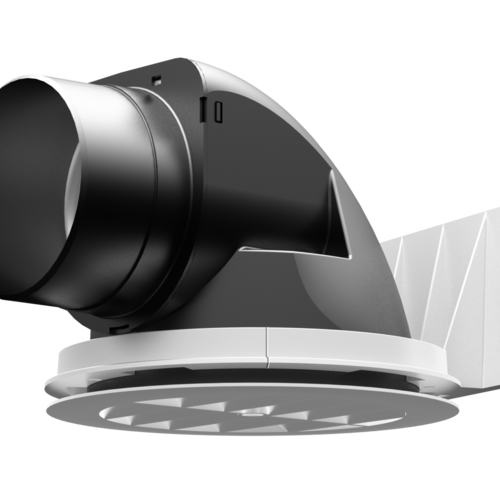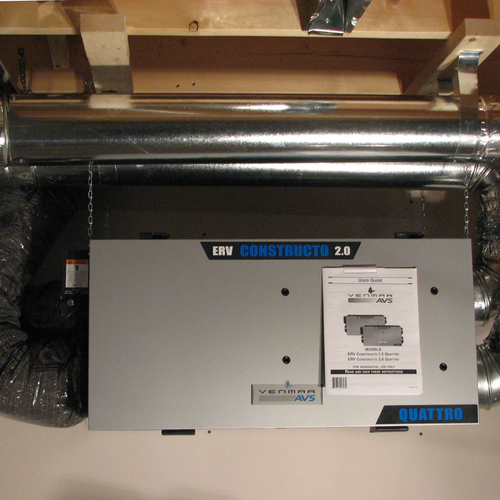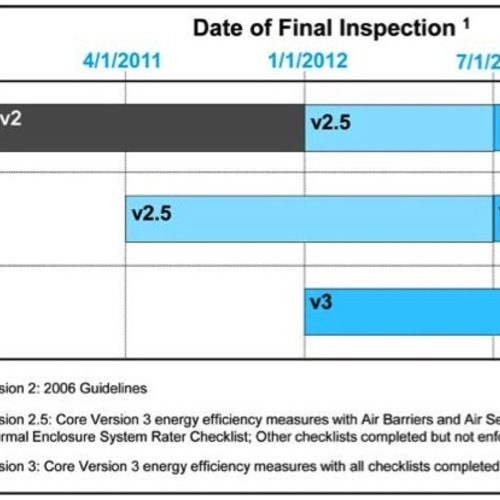Image Credit: Energy Vanguard
Image Credit: Energy Vanguard A bath fan that can move enough air. The fan is oversized. The duct is short, straight, and oversized.
Image Credit: Energy Vanguard
Let me tell you a little story about the day that Jeffrey went to test several Habitat for Humanity houses that are going for certification in the Energy Star new homes program (the one in the photo here was not one of them). This was a couple of weeks ago, but I wrote down the numbers he told me because I think you may be somewhat surprised.
This isn’t an issue unique to Habitat, though. If you’ve done the kind of testing required for Version 3 of the Energy Star program, you’ve likely seen similar numbers for the failures I’m about to describe.
The little hitch that snares
One of the requirements in Energy Star Version 3 is that bath fans have to be able to exhaust at least 50 cubic feet per minute (cfm) of air. It’s got to be measured by a HERS rater as one step among many in the required commissioning process. Many builders going for Energy Star have learned that fans rated at 50 cfm generally don’t cut it. This particular Habitat affiliate, as a result of early failures, made the decision to install fans rated at 110 cfm in all their homes.
Should be pretty easy to hit 50 cfm with a 110 cfm fan, right? No, not necessarily.
Jeffrey tested 9 fans, all rated at 110 cfm. Want to guess how many passed on the first try? Well, the actual number was five. That’s right. Only five out of nine fans passed.
And even their results weren’t stellar. None of them even hit 100 cfm. One barely made it across the finish line with 51 cfm. The other four were between 51 and 85 cfm.
And the four losers? Their exhaust flow rates were 30, 45, 45, and 46 cfm. Did I mention that the fans were rated for 110 cfm? Those four fans couldn’t even get 45% of their rated air flow!
If you’re a builder, HERS rater, or HVAC contractor working on Energy Star homes, what kind of failure rates are you seeing on bath fan exhaust flow rates?
How we measure bath fan flow rates
The photo below shows Andrew Woodruff of Building Performance Engineering in Boone, NC using the exhaust fan flow meter from the Energy Conservatory. We use the same device, as do many HERS raters. You just hold it over the fan with the fan turned on and measure the pressure difference with a manometer. The range of exhaust flow rates it measures is from 10 to 124 cfm with an accuracy of ±10%. They’re quick, easy to use, much less expensive than a flow hood, and way lighter than a powered flow hood.
How to pass on the first attempt
These Habitat builders have modified their processes to ensure they get their homes certified, but they’re still working on some of the details. Here’s the full solution:
- Use a higher capacity fan. You shouldn’t count on getting 50 cfm out of a 50 cfm fan, but I don’t think you need to go all the way to 110. A fan rated for 80 cfm should be fine.
- Install the housing with the duct port facing the right direction. It’s amazing how often I see them installed so that the duct has to make an immediate 180 degree turn.
- Shorten the duct runs. Don’t run the duct all the way across the attic. Try to keep the duct length to less than 10 feet.
- Upsize the duct. Go with a 6-inch duct rather than 4-inch.
- Use hardpipe or install flex perfectly. Poorly installed flex can zap the oomph right out the air.
- Make sure the damper in the fan is operating properly. Sometimes a screw prevents it from opening or the installer neglects to remove a piece of tape from the factory.
- Make sure the wall cap or roof vent is operating properly. Sometimes those dampers stick, or get screwed or painted shut.
The third photo below shows a bath fan installed so that it does almost all those things and should have no trouble passing the air flow test. It does have one little issue: the crimp where it goes across the first 2×4. Jeffrey tested this house last week, and it came in at over 100 cfm, though, so it was fine.
If you’re doing work on Energy Star homes, it’s good to keep these things in mind. Jeffrey doesn’t like to go back out for reinspections, and your HERS rater probably doesn’t either.
Allison Bailes of Decatur, Georgia, is a speaker, writer, energy consultant, RESNET-certified trainer, and the author of the Energy Vanguard Blog. You can follow him on Twitter at @EnergyVanguard.
Weekly Newsletter
Get building science and energy efficiency advice, plus special offers, in your inbox.
















19 Comments
What??
The fan rough-in in your second shot looks iffy to me. The flex is already compressed a bit over the top of the truss chord, at the transition piece, and it hasn't even been covered with insulation yet. They should have tacked a piece of 1x up for the flex to lay on.
Response to David Meiland
Yes, I mentioned that in the article. Either they fixed it or it didn't have much effect because it tested at ~100 cfm.
Smart flow technology
This is one of the reasons that I only use and recommend to my builder clients Panasonic Whisper Green fans. In addition to their other great attributes and extremely low energy consumption, they incorporate what they call Smartflow Optimum CFM technology. Essentially the Fan senses the static pressure and increases the motor speed to compensate. Even with that, I agree that all of the steps above are critical and I guess it's time to add the flow box to my arsenal.
One thing I would also caution is not going too far the other direction. I tend to be more in the Lstiburek camp on ventilation rates and would not recommend to a client to blindly over-ventilate everywhere in order to plan for the worst. An average 2000 sf home can have as many as 4 fans and if they shot for 100 cfm everywhere and installed them properly you could easily be way over-ventilated. One could argue that you could install the bigger fans and then simply increase the static pressure to bring the cfm rate down but typically as you add static pressure, you also increase the energy consumption, even with the Panasonic.
Best to size right, install properly and test.
Can a duct run be too short?
I had a builder tell me that a too-short duct run can lead to cold air making it to the fan body, and subsequent rain in the bathroom from the condensation. Thoughts?
Response to Daimon Doyle
I didn't discuss the connection of bath fans with whole house ventilation, but you do raise a good point. ENERGY STAR requires you to meet ASHRAE 62.2-2010 ventilation rates, and if you're doing that by using the bath fans, you do need to consider that total flow. Putting in larger fans means that you adjust the controller to run less often, though.
Response to Eric Sandeen
Outside air can make it to the bath fan no matter the length. The best solution for that is a good cap for the outdoor penetration through the roof, soffit, or wall and a backdraft damper that works. If the damper built into the fan isn't stopping the air, a cape damper (http://ow.ly/oaEZc) will.
Response to Eric Sandeen
Eric,
The drips (or "rain") from a ceiling-mounted bath fan aren't due to exterior air leaking inward. They are due to interior air leaking outward.
When warm, humid indoor air leaks (or is blown) through the exhaust duct, it sometimes contacts cold ductwork, causing condensation -- especially during the winter. This condensed interior moisture can sometimes drip back toward the fan.
There are two ways to limit this problem:
1. Insulate all of the ductwork in your attic.
2. Run your exhaust duct vertically until it is high enough to give you the needed elevation; then install an elbow aiming at your gable wall. Install the rest of the duct so it slopes downward to the gable exit. This method will ensure that condensed moisture flows out of your house, not toward your ceiling. (Of course, the duct should be secured with hangers or straps so that it doesn't sag.)
Cold climate bias to the rescue
Thanks for covering the cold-outside/warm-and-humid-inside angle. My warm climate bias—and the house I looked at just last week that had humid outside air coming in and growing mold on the bathroom ceiling—blinded me temporarily to what happens in winter.
Response to Allison Bailes
Allison,
So, in your experience -- if the house is air-conditioned, is it possible for exterior humid air to reach cold metal parts -- perhaps the fan housing -- during the summer, leading to ceiling drips?
No summer ceiling drips but...
Martin,
No, I haven't seen summer ceiling drips but we did just have a case where power attic ventilators were backdrafting two bath fans enough to make the humidity at the ceilings equal the outdoor humidity. The result was mold on the ceilings. It's possible to get visible condensation on the supply register in a bathroom, though, but it's not usually enough to drip like some bath fans do in winter.
Powered attic ventilators!
Powered attic ventilators cause so many problems that they will keep home performance contractors busy for years to come...
Response to Allison & Martin
Thanks for the replies. Glad I could spark a conversation between you two gurus, and remind Allison that it gets cold out in some parts of the country. :) This builder's solution is to do a dreaded u-turn out of the fan to make the duct longer. I'll push for other solutions...
Could it possibly be that the
Could it possibly be that the static pressure increases on a exhaust fan if the house is really airtight? Just a thought would like to hear your opinion!
Response to Philipp Gross
Philip,
It is certainly possible to build a house that is so tight that there aren't enough random envelope cracks to provide makeup air to a bath exhaust fan. But it would be hard. Such homes are very rare.
It's far more common for bath exhaust problems to be due to ducting issues: long ducts, convoluted ducts, ducts with too many elbows or tight turns, ducts that are pinched or compressed, or ducts that have too small a diameter.
Response to Philipp Gross
That's a good question and something we've looked for in our work. We haven't found a house yet, even among those that are down in the 1-2 ACH50 range, where a bath fan had difficulty moving enough air because of the airtightness of the house. Anthony Grisolia of Ibacos, however, says they have seen such an effect. (Thanks for reminding me to follow up with him.) You can read more discussion of this topic in the comments for this article posted in the Energy Vanguard Blog.
supply air
Given that the bathroom door is probably closed, I suspect that it's quite easy to cause a significant reduction in ventilation airflow without a source of supply air.
Response to Jon R
Jon,
The reality is that bathroom doors aren't weatherstripped, so makeup air enters the bathroom through the crack between the bottom of the door and the flooring, as well as through the cracks at the other three sides of the door; through cracks around the window, if there is a window; through cracks between the exhaust fan housing and the ceiling drywall; through cracks between the bottom plate of the exterior wall and the subfloor; and through wall-mounted electrical boxes that draw air from partition stud bays communicating with the whole house.
Another Potential Flow Restriction (Soffit Caps)
I had one low-flow situation that had me scratching my head. Panasonic fan, 2nd floor bathroom, short duct run (admittedly flex), BUT unrestricted--daylight from the end of the duct run showed a full diameter path. I *think* what was happening was that the soffit cap was pretty restrictive. I looked at another soffit vent, and it's a round, spring-loaded unit. With the fan running, the damper moved only ~1/2"--that's a net free area of around 6 square inches. A 4" duct has a free area of 12.6 square inches. I bet that this vent cap does a great job of preventing cold air complaints, but a lousy job of letting air through.
Response to Kohta Ueno
Kohta,
Good detective work -- thanks for sharing.
I never have liked soffit terminations. I think you have just provided one more reason to avoid them.
Log in or create an account to post a comment.
Sign up Log in